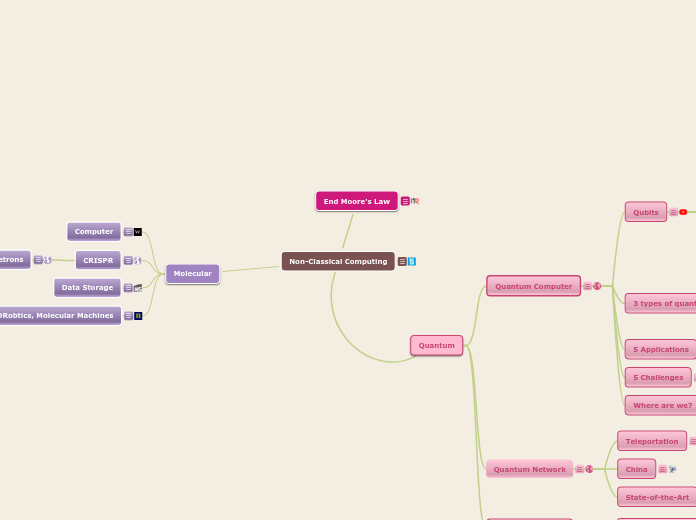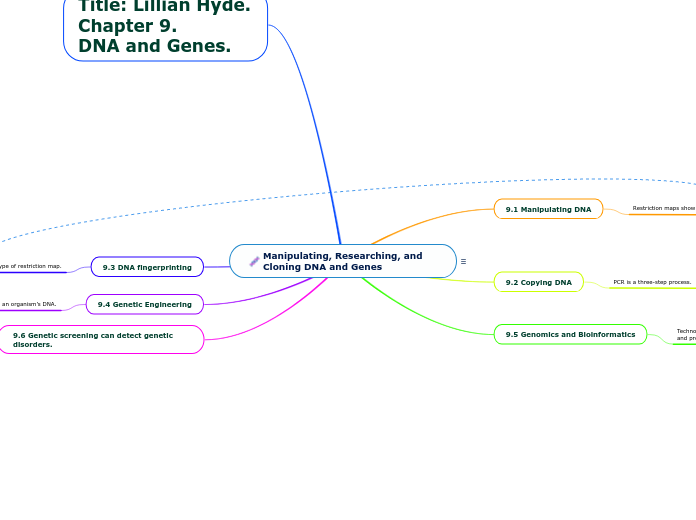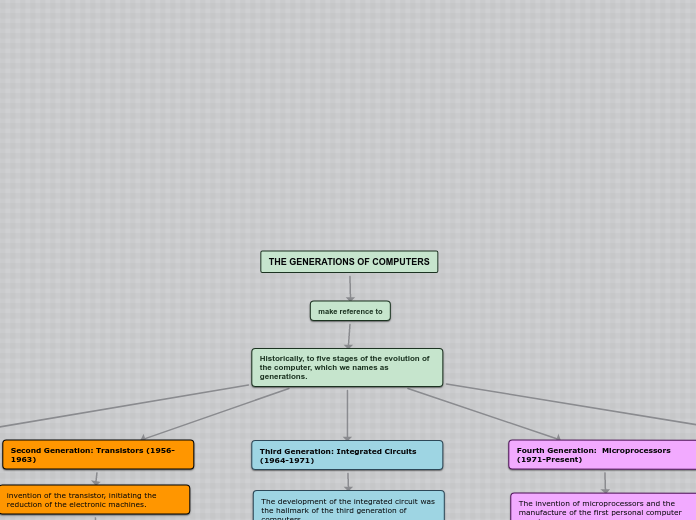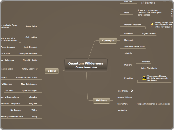Non-Classical Computing
Quantum computers promise an exponential increase in power compared with today’s classical CMOS-based systems. This increase is of a magnitude that is difficult for the human mind to comprehend. So there is real excitement that quantum computers will deliver benefits that are not possible with today’s systems. With such promise, we are seeing the rise of quantum computing prophets who say that, in just a few years, these machines will have the ability change the world. And conversely, we’re seeing more quantum computing skeptics who say it will never happen.
End Moore's Law
https://line.17qq.com/articles/atqrsewax.html
Transistors are down to the size of a single atom
Quantum
Quantum Sensors
What is a quantum sensor?
Quantum sensors utilize quantum states for measurements. They capitalize on the fact that quantum states are extremely sensitive to disturbances – this means that they also have the potential to become extraordinarily sensitive measuring instruments.
https://www.chalmers.se/en/centres/wacqt/discover/Pages/Quantum-sensing.aspx
Quantum Positioning System
The project has advanced its development of a cold atom-based Quantum Positioning System (QPS), which enables vehicle navigation without a GPS (Global Positioning System) or GNSS (Global Navigation Satellite System) signal.
Reducing the reliance on GPS and GNSS technologies is critical for scenarios where signals from these systems are not available, such as underwater or in space, or when they suffer disruptions due to technical issues, cyberattacks, and atmospheric or reflection effects. High-BIAS2 demonstrates the rapid commercialization of quantum technologies for real world applications.
https://theoxfordtrust.co.uk/new-milestones-for-development-of-coldquantas-quantum-positioning-system-qps/
Quantum Network
At the end of last year, a monumental breakthrough was announced with the first case of long-distance, high-fidelity quantum teleportation. This was quickly followed by the creation of a cryogenic quantum computer chip, and even a hologram using quantum entanglement just after that. You could say it has been a pretty big few months for the eventual goal of a quantum Internet, which could theoretically change everything when it comes to computing speed, privacy, and capabilities.
State-of-the-Art
Quantum machine learning is the intersection between quantum computing and AI that might change what the future of computing looks like.
https://medium.com/illumination-curated/is-quantum-machine-learning-the-next-thing-6328b594f424
China
Chinese scientists have established the world's first integrated quantum communication network, combining over 700 optical fibers on the ground with two ground-to-satellite links to achieve quantum key distribution over a total distance of 4,600 kilometers for users across the country. The team, led by Jianwei Pan, Yuao Chen, Chengzhi Peng from the University of Science and Technology of China in Hefei, reported in Nature their latest advances towards the global, practical application of such a network for future communications.
https://phys.org/news/2021-01-world-quantum-network.html
Teleportation
Qubits need to be kept isolated, otherwise they decohere and lose their overall usefulness. "This is a very big problem if you want to create a scalable network, so what you can do is use quantum teleportation, which leverages quantum entanglement to enable sending qubits over longer distances."
Quantum Computer
Quantum computing (QC) is an emerging technology with a lot of promise. It fundamentally changes the way we perform calculations by relying on probabilities rather than logical paths.
Where are we?
Scientists have made a significant improvement on previous designs in photonic systems that could make quantum computing a viable reality in the near future.
Researchers at CRANN and the School of Physics at Trinity College Dublin have created a new device that will emit single particles of light, or photons, from quantum dots that are the key to practical quantum computers, quantum communications, and other quantum devices.
The device allows for controllable, directional emission of single photons and which produces entangled states of pairs of quantum dots.
https://www.theweek.in/news/sci-tech/2020/07/14/scientists-achieve-breakthrough-towards-quantum-future.html
5 Challenges
https://spectrum.ieee.org/tech-talk/computing/hardware/an-optimists-view-of-the-4-challenges-to-quantum-computing
- Qubit Quality: We need to make
that we will be able to generate useful instructions or gate operations for on a large scale. As a community, we are not there yet. Even the few qubits in today’s cloud-based quantum computers are
not good enough
- for large scale systems. They still generate errors when running operations between two qubits at a rate that is far higher than what we would need to effectively compute. In other words, after a certain number of instructions or operations, today’s qubits produce the wrong answer when we run calculations. The result we get can be indistinguishable from noise.
- Error Correction: Now, because qubits aren’t quite good enough for the scale we need them to operate at, we need to implement error correction algorithms that check and then correct for random qubit errors as they occur. These are complex instruction sets that use many physical qubits to effectively extend the lifetime of the information in the system. Error correction has not yet been proven at scale for quantum computing, but it is a priority area of our research and one that I consider a prerequisite to a full-scale commercial quantum system.
- Qubit Control: In order to implement complex algorithms, including error correction schemes, we need to prove that we can control multiple qubits. That control must have low-latency—on the order of 10’s of nanoseconds. And it must come from CMOS-based adaptive feedback control circuits. This is a similar argument to that made in the aforementioned IEEE Spectrum article. However, though it is daunting, I have every reason to believe it is not impossible.
- Too Many Wires: Finally, we need to address “fan-out”—or how to scale up the number of qubits within a quantum chip. Today, we require multiple control wires, or multiple lasers, to create each qubit. It is difficult to believe that we could build a million-qubit chip with many millions of wires connecting to the circuit board or coming out of the cryogenic measurement chamber. In fact, the semiconductor industry recognized this problem in the mid-1960s and designated it
- Decoherence: can be viewed as the loss of information from a system into the environment (often modeled as a heat bath since every system is loosely coupled with the energetic state of its surroundings.
5 Applications
- drug design by mimicking molecules
- quantum simulation
- cryptography
- Finance- portfolio optimization
- Search
- Weather prediction
https://www.paconsulting.com/insights/what-is-quantum-computing-performance-applications-evolution/#:~:text=Rather%20than%20valves%20and%20vacuum,run%20calculations%20and%20correct%20errors.
3 types of quantum computer
1. Quantum Annealer
Quantum annealing is defined to be the generic solver for optimization problems. Researchers are still finding ways to explore the most efficient configurations amongst multiple possible combinations of variables. Quantum annealing is still projected as the least powerful and narrow usage of quantum computing.
2. Analog Quantum Simulations
Analog quantum simulators help in addressing physics problems that are way beyond the ability of classical systems. Quantum simulators solve some of the toughest biochemistry problems such as simulating a protein folding. For instance, misfolded proteins tend to cause diseases such as Parkinson’s and Alzheimer’s. Therefore, with the help of random computing model researchers will be able to test which drugs can be used for treatments.
3. Universal Quantum
Heralded as the most powerful and most generally used quantum computing, universal computing is the hardest to build. Ideally, universal computing is said to access more than 100,000 qubits i.e. 1M qubits. In the present time, we can hardly access 129 qubits.
Most amount of qubitat this time
Quantum Volume
The IBM team introduced the Quantum Volume metric specifically because a classical computer’s transistor count and a quantum computer’s quantum bit count aren’t the same. Qubits decohere, today forgetting their assigned quantum information in less than a millisecond. A quantum computer with a few, low-error, highly connected, and scalable qubits will probably bring us closer to the goal of a universal, fault-tolerant quantum computer — one capable of performing advanced quantum algorithms and powerful molecular simulations — than a device with lots of especially noisy, error-prone qubits would.
https://medium.com/qiskit/what-is-quantum-volume-anyway-a4dff801c36f
Qubits
Explain the difference between a classical bit and a qubit.
https://youtu.be/HdSmIUuGf-I 1:45 time
Bit = 1 or 0
Qubit= 1 and 0
photon, electron, ion, atom
Hot Qubits
Hot qubits are the major key to overcome any obstacle the scale needs for the new technology
https://www.youtube.com/watch?v=v-_GQBszZYg
Observer Effect
the act of observation changes the outcome
Superposition
Qubits can be in multiple states at the same time.
https://www.youtube.com/watch?v=JhHMJCUmq28
3:23
Entanglement
a close connection that makes each of the qubits react to a change in the other's state instantaneously
https://www.youtube.com/watch?v=JhHMJCUmq28
4:15
Molecular
NANORobtics, Molecular Machines
DNA nanorobots designed in minutes instead of days
“But now, nanodevices that may have taken us several days to design before now take us just a few minutes,” Castro said. And now researchers can make much more complex – and useful – nanodevices.
https://www.nanowerk.com/nanotechnology-news2/newsid=57809.php
Data Storage
DNA inside living bacterial cells has been edited with
CRISPR technology to encode and store information. This could be a step towards developing a new medium for long-term data storage.
https://www.newscientist.com/article/2264383-crispr-gene-editing-used-to-store-data-in-dna-inside-living-cells/#ixzz6u1G5eFfm
CRISPR
- CRISPR is a genome-editing tool. It is used by researchers/health care professionals to alter DNA sequences and modify gene function.
- CRISPR is also used to correct genetic defects, treat human diseases, and yield better crop varieties
- CRISPR stands for Clusters of Regularly Interspaced Short Palindromic Repeats. The CRISPR-Cas9 system consists of two key molecules: Cas9 and guide RNA, which introduces a change or mutation into the DNA at the desired position.
- Cas9 is an enzyme that acts as a pair of ‘molecular scissors’ and can cut the two strands of DNA at a specific location in the genome so that bits of DNA can then be added or removed
- The guide RNA (also known as gRNA) is a small piece of pre-designed RNA sequence (about 20 bases long) located within a longer RNA scaffold. The scaffold part binds to DNA and the pre-designed sequence ‘guides’ Cas9 to the right part of the genome.
- This makes sure that the Cas9 enzyme cuts at the right point in the genome. High orthogonality, versatility, and efficiency of CRISPR technology make it a preferred genome editing technology.
https://www.biospace.com/article/crispr-technology-market-rise-in-focus-on-gene-therapeutics-is-projected-to-contribute-to-the-growth-of-the-market/
Retrons
Retrons are segments of bacterial DNA that undergo reverse transcription to produce fragments of single-stranded DNA (ssDNA). Retrons’ existence has been known for decades, but the function of the ssDNA they produce flummoxed scientists from the 1980s until June 2020, when a team finally figured out that retron ssDNA detects whether a virus has infected the cell, forming part of the bacterial immune system.
While retrons were originally seen as simply a mysterious quirk of bacteria, researchers have become more interested in them over the last few years because they, like CRISPR, could be used for precise and flexible gene editing in bacteria, yeast, and even human cells.
https://wyss.harvard.edu/news/move-over-crispr-the-retrons-are-coming/
Computer
DNA computing is recognized as one of the most outstanding candidates of next‐generation molecular computers that perform Boolean logic using DNAs as basic elements. Benefiting from DNAs’ inherent merits of low‐cost, easy‐synthesis, excellent biocompatibility, and high programmability, DNA computing has evoked substantial interests and gained burgeoning advancements in recent decades, and also exhibited amazing magic in smart bio‐applications.
https://onlinelibrary.wiley.com/doi/full/10.1002/advs.202001766









